ISSN: 1705-6411
Volume 10, Number 1 (January 2013)
Author: Dr. Gerry Coulter
I. Introduction
…fashion has the fabulous character of the more beautiful than beautiful: fascinating. The seduction it exerts is independent of all value judgment (Baudrillard [1983] 1990:8).
There’s no way back for me now, I’m going to take you on journey’s you’ve never dreamed were possible (McQueen in Watt, 2012:206).
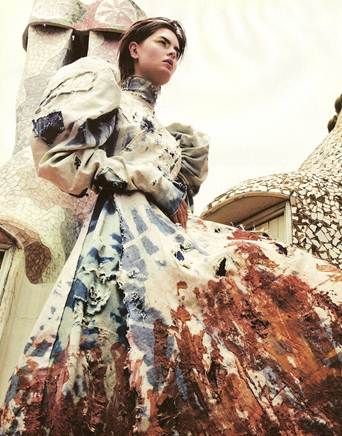
1. Alexander McQueen. Denim Dress from Eshu Show, (Autumn/Winter, 2000-2001)
Every so often, both because of and despite itself, the world of fashion throws forward an individual who’s vision is so creatively radical, so extreme, that it refuses to go unnoticed. In recent years such eruptions often coincided with the work of one most innovative designers of all time – the recently deceased Alexander McQueen. The principle reason I find McQueen unavoidable, and indeed I find his work desirable from a theoretical point of view, is that he was not only a highly innovative designer of clothing, but because he was an artist of exceptional abilities – an artist who’s media was predominantly cloth: “For me, what I do is an artistic expression which is channelled through me. Fashion is just the medium” (McQueen, in Bolton, 2011: 92).
My attraction to McQueen’s work is also nuanced by my interest in the writing of Jean Baudrillard who’s thought is also considerably artistic (poetic) [see Coulter, 2011, 2012]. Baudrillard was attracted to the extremities of culture [and to the extreme generally] for what it could tell us about the eruption of the more real than real – the hyperreal. Fashion, as an extreme art form, often attracted the attention of his writing. In his earlier writings he said that fashion is very important to the system in that in continually “announces the myth of change” in a manner essential to our contemporary circumstance: “Modernity is not the transmutation of all values but the commutation of all values, their combination and the ambiguity. Modernity is a code, and fashion is its emblem” (Baudrillard [1976] 1993: 90). Baudrillard found fashion to be an important place for the recycling of the desire for death: “…emptying it of every subversive phantasm and involving it, along with everything else, in fashion’s innocuous revolutions” (Ibid.: 88). He also observed that in fashion we see a radical liquidation of values, indeed, the most radical liquidation of values we know: “… under the sign of fashion, all cultures play like simulacra in total proximity” (Ibid.). There are few designs that bear this statement out in recent fashion than McQueen’s “decorated body armor”.
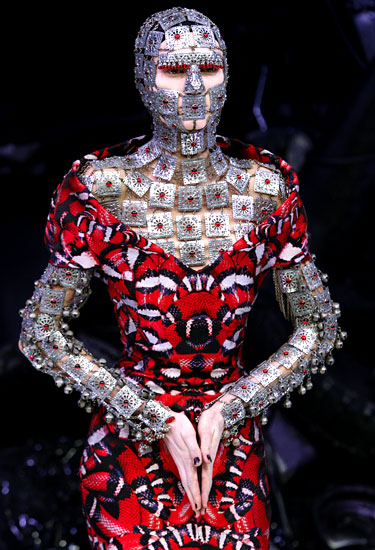
2. Alexander McQueen. Crystal decorated body armor from The Eye Show, (Autumn/Winter, 1999-2000).
In the world of fashion, Baudrillard could find neither progress nor liberation – for him any liberation women experience in fashion is “exactly as the proletariat is only ever liberated into the labour force” (Baudrillard [1976]1993: 97). Later he would observe, quite correctly I think, that fashion was the despair of sociology and aesthetics both: “a prodigious contagion of forms in which chain reactions struggle for supremacy over the logic of distinctions” ([1990] 1993: 70).
And so, as I often find myself, I’m being written by a paper that meets at a point along two intersecting planes – in this case the writing of Jean Baudrillard and the fashion designs of Alexander McQueen. To frame my concern as a question: How does Baudrillard help us to understand the extraordinary [hyperreal] phenomenon that was the fashion of Alexander McQueen?
While Baudrillard did not write about McQueen or his work, he did leave us many theoretical insights which help us to locate McQueen – the artist of cloth. Specifically I will draw on Baudrillard’s thought concerning 1) the role of potlatch and excess, 2) the imaginary dimension of life, and 3) the commutation of the beautiful and the ugly. The remainder of this paper argues that these aspects of Baudrillard’s thought help us to identify why it is that the hyperreal Alexander McQueen so seduced us with his artistic visions.
II. Fashion – Echoes of Potlatch
Fashion, like language, is aimed at the social from the outset (the dandy in his provocative solitude, is the a contrario proof of this). But, as opposed to language, which aims at meaning [sens] and effaces itself before it, fashion aims for a theatrical sociality, and delights in itself… the mirror of a certain desire for its own image. …It is especially fashion… playing over the signs of the body, that appears festive, through its aspect of wasteful consumption, of potlatch (SD:94).
The shows are what spur me on, make me excited about what I’m doing. When you start getting into a mindset where this is a business and you’ve got to bring in money, when you’re designing with a buyer in mind, the collection doesn’t work… (McQueen in Watt, 2012: 85).
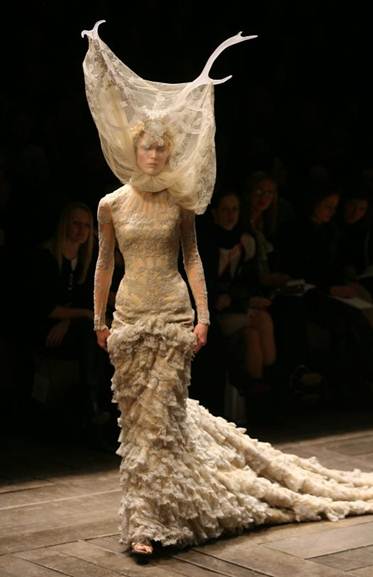
3. Alexander McQueen. Oyster Dress from Widows of Culloden Show, (Autumn/Winter, 2006).
Highly successful and interesting entries into the fashion arena often come close to both self parody and a parody of fashion more generally. These extreme artistic performances in cloth [and accessories] are propelled down the runway as much by the energy of a potlatch as by the frail bodies of the models. When McQueen was at his best his work participated at the highest level in the ritual of excess that is fashion (see Baudrillard [1976] 1993: 90). ‘Great’ designers like McQueen [see especially image 2 above] participate in an ecstasy of surplus form detached from the real conditions under which clothing is made, merchandized, and worn. This ecstasy of form [and value] is an important aspect of ‘potlatch’ which persists despite the dominant myth of shortage and scarcity in Western political economy. The design excesses of McQueen illuminate the myth of Western political economy by demonstrating that there is too much. Where there is excess there is potlatch – an enormous expenditure of excess (including aesthetic excess), which bears an enormous resemblance to a kind of ritual [performed each Spring and Fall by the fashion industry]. As such, the world of fashion relies on highly provocative artists like McQueen who understand that fashion is best when it operates under the sign of excess – not unlike the excess that is squandered, for the good of the whole, in potlatch. Baudrillard notes that in fashion this potlatch is an important part of a symbolic destruction: “Potlatch, religion, indeed the ritual enchantment of expression, like that of costume and animal dances: everything is good for exalting fashion against the economic, like a transgression into a play-act sociality: …We would like to see a functional squandering everywhere so as to bring about symbolic destruction” (Ibid.: 94).
As such Baudrillard’s thought helps us to understand that the role of a designer of McQueen’s abilities is to serve as a kind of high priest of the sacred ritual of fashion at the most prestigious level of the game. The role of the designer as high priest is to constantly bid aesthetic values to higher and higher levels. If the work of McQueen, or the spectacle of high-fashion generally, echoes potlatch in its unruly advance, it is more important for the mythic character of the fashion show as event [than in any technical or commercial spin-offs] (Baudrillard makes a similar case concerning Formula One racing ([2000] 2002: 169). What is expended in fashion is a kind of surplus aesthetic. Without artists such as McQueen this aspect of fashion would be greatly diminished and we would pay much less attention. The burning off of the excess that is the fashion show at its acme is what commands our attention. The fashion show at this level spends inordinate sums, far beyond marketable feasibility, to address a passion for reputation and prestige. McQueen’s personal and artistic charisma were vital to his role in a process which constantly tinkers with the code in order to reinforce the institution: “That’s what I’m here for, to demolish the rules but keep the tradition” (Alexander McQueen in Watt, 2012:216).

4. Alexander McQueen. Dress of green and bronze cotton and synthetic lace debuted in Highland Rape show, (Autumn/Winter, 1995-1996)
III. McQueen – Ravaging the Imaginary
The pleasure of fashion is undeniably cultural in origin, but does it not stem even more clearly from a flaring, unmediated consensus generated by the interplay of signs? Moreover, fashions fade away like epidemics once they have ravaged the imagination (Baudrillard [1990] 1993: 70).
My collections have always been autobiographical… they were to do with my childhood, the way I think about my life and the way I was brought up to think about my life (McQueen in Watt, 2012:65).
McQueen appears to have understood, as consummate showmen tend to do, that what floats along the catwalk, along with what is worn by the models, is the imaginary of both designer and audience. As such, McQueen understood that fashion is not merely spectacle – but the kind of spectacle that Baudrillard referred to as “enchanting”: “The acceleration of the simple play of signifiers in fashion becomes striking, to the point of enchanting us…” ([1976] 1993: 87). What fashion ultimately does, how it seduces, and how it succeeds [and this is nowhere more true than of McQueen’s oeuvre], is by “imposing upon us a rupture of an imaginary order” and “we suffer profoundly from the corruption of rationality it implies, as reason crumbles under the blow of the pure and simple alteration of signs” (Ibid.: 87-88).
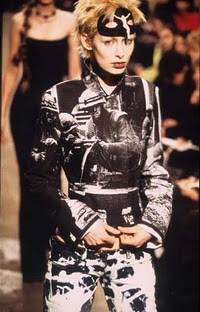
5. Alexander McQueen. Jacket painted with images from Vietnam by Don McCullin from the Dante Show (Autumn/Winter, 1996-97)
McQueen ravages the imagination [see Baudrillard [1990] 1993: 70] of those who attend his shows as a result of the process of plumbing the depths of his own bright and dark sides as he attempted to do in his Voss show (2001).
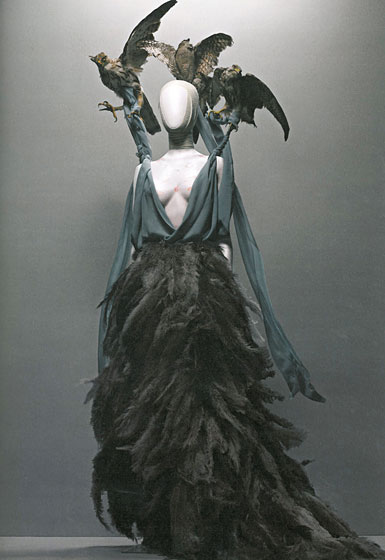
6. Alexander McQueen. Shirt of light blue silk, skirt of ostrich feathers, taxidermy birds, debuted in the Voss Show, (Spring/ Summer, 2001)
Of the Voss show McQueen said: “…the idea was to turn people’s faces on themselves… the show was staged inside a huge two way mirrored box, whereby the audience was reflected in the glass before the show began” (in Bolton, 2011: 142). The fashion show is a grand and beautiful game (Baudrillard, 1993: 95). For McQueen, whether it dealt with light or dark, good or evil, the fashion show is very much “a happy form” (Baudrillard, 1987:100). McQueen often attacked reason in his shows, ravishing our imaginary order, indeed rupturing it temporarily, by way of a kind of acceleration of the play of signifiers his clothing performed (Baudrillard [1976] 1993: 87). Despite the ravage and the rupture, indeed because of it, and because of the severe alteration of signs (Ibid.: 88), McQueen’s audience were engaged to participate in the “pleasure of fashion”. McQueen thus came close to the impossible in his shows as he approached the point of subverting fashion. Yet, through his art, he affirmed fashion in the end because he participated in what fashion is – a system so without reference that no designer could ever fully contradict it (Ibid.).
IV. The Commutation of beautiful and ugly in Fashion
Beauty can come from the strangest of places, even the most disgusting places… it’s the ugly things I notice more (McQueen in Bolton, 2011: 196).
The real does not efface itself in favour of the imaginary; it effaces itself in favour of the more real than real: the hyperreal (Baudrillard [1983] 1990: 11).
McQueen was also a master of the commutation of the beautiful and the ugly – one of Baudrillard’s most striking observations concerning fashion. Baudrillard understood, as most successful fashion designers do, that “truly beautiful, definitively beautiful clothing, would put an end to fashion” ([1972] 1981: 79). What fashion shows preserve is “the alibi of beauty” (Ibid). Fashion designers like McQueen appear to instinctively understand that, as Baudrillard captured it: “… fashion has the fabulous character of the more beautiful than beautiful” ([1983] 1990: 9).
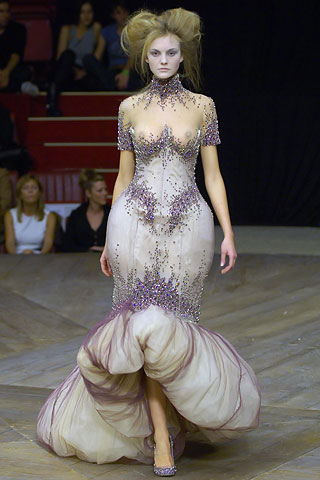
7. Alexander McQueen. Lilac tulle bustled evening dress, from the Sarabande Show (Spring/Summer, 2007)
Indeed, fashion is properly understood for Baudrillard, as it appears to be for McQueen, as neither beautiful nor ugly” ([1997] 1998: 73). Thus it is an integral part of our contemporary moment when uncertainty characterizes all of our value systems. As such, the work of an artist-designer like McQueen, seduces us by making things of beauty “which have absorbed all the energy of the ugly” ([1983] 1990: 9). Fashion thus becomes, and there is no better example once again than the work of McQueen: “the ecstasy of the beautiful: pure and empty form spinning about itself” (ibid). This moment of ecstasy contributes to McQueen’s status as an artist from a Baudrillardian perspective: “this is precisely where today’s art seeks to go beyond itself, to deny itself deny itself and the more it seeks to fulfill itself in this way, the more hyperreal it becomes and the more it transcends itself toward its empty essence” (Ibid.: 19). McQueen, as a leading contemporary artist-designer, thus participated in the thing that art does best in recent years, creating nothing more than the magic of its disappearance (Ibid.: 10). Where language aims at communication – fashion plays at it. Fashion’s enchanting festival is an excess of communication… a potlatch of the aesthetic which ravages the imagination by way of the exchange of the beautiful and the ugly. As this is what fashion is and does then Alexander McQueen was fashion.
As for McQueen’s early demise – perhaps it was a powerful demonstration of an unparalleled understanding of the magic of disappearance that is also fashion.
About the Author
Gerry Coulter is the Founding Editor of IJBS. His book: Jean Baudrillard: From the Ocean to the Desert – The Poetics of Radicality (Intertheory Press, USA, 2013) is available at: http://intertheory.org/gerrycoulter.htm. Other recent publications include: “Jean Baudrillard: The Poetic and Literary Philosopher” in Sebastian Husch (Editor): Philosophy and Literature and the Crisis of Metaphysics”. Würzburg, Germany: Königshausen and Neuman (2011); and “Jean Baudrillard in the 21st Century (and after)”. In Fast Capitalism Journal, Volume 8, Number 2 (2011): http://www.fastcapitalism.com. He is currently preparing a manuscript for publication in 2013: Art In / After Poststructuralism: Surviving Baudrillard’s Challenge.
References
Jean Baudrillard ([1972] 1981). For A Critique of the Political Economy of the Sign, St. Louis, Mo: Telos Press).
Jean Baudrillard ([1976] 1993). Symbolic Exchange and Death. London: Sage.
Jean Baudrillard (1987). Forget Baudrillard: An Interview With Sylvere Lotringer, pp. 55-135 of Forget Foucault, Forget Baudrillard. New York: Semiotexte.
Jean Baudrillard ([1983] 1990). Fatal Strategies: Revenge of the Crystal. New York: Semiotext(e)/ Pluto Press, 1990.
Jean Baudrillard (1993). Baudrillard Live: Selected Interviews (1982-1993). Edited by Mike Gane, London: Routledge.
Jean Baudrillard ([1997] 1998). Paroxysm: Interviews with Philippe Petit. New York: Verso.
Jean Baudrillard ([2000] 2002). Screened Out. New York: Verso.
Andrew Bolton et. al., (2011). Alexander McQueen: Savage Beauty. An exhibition catalogue for The Metropolitan Museum of Art (New York: May 4 – July 31, 2011). New Haven: Yale University Press.
Gerry Coulter (2012). Jean Baudrillard: From the Ocean to the Desert – The Poetics of Radicality. Intertheory Press, USA.
Gerry Coulter (2011). “Jean Baudrillard: The Poetic and Literary Philosopher” in Sebastian Husch (Editor): Philosophy and Literature and the Crisis of Metaphysics”. Würzburg, Germany: Königshausen and Neuman.
Judith Watt (2012). Alexander McQueen: The Life and Legacy. New York: Harper.